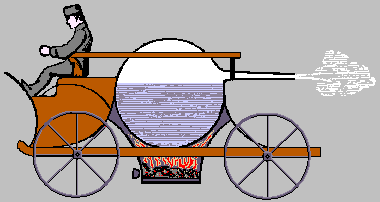 |
| Sir Isaac Newton's Steam Carriage proposed in 1680 |
Traction engines, mobile steam engines, evolved from the rudimentary stationary steam engines which were developed during the late 18th century.
The inpact of steam driven road engines must have been considerable because the operators of stationary steam engines are still referred to as "drivers".
Although no single person can be credited with having invented the steam powered road vehicle, the French military engineer Nicolas Cugnot (1725�1804) possibly presented the most advanced ideas of the time.
Cugnot's first self-propelled steam engine was first demonstrated in the Paris Arsenal before distinguished government and military officials on October 23rd, 1769. The three-wheeled vehicle was was developed for the towing of artillery and ran for fifteen minutes achieving an impressive two miles per hour. It could also carry four people.
Cugnot's second engine was demonstrated before the public in the streets of Paris but collided with a wall during the demonstration. His reputation was destroyed with the engine and subsequent lack of support prevented Cugnot from developing his engines further.
A replica of Cugnot's engine is preserved in the Paris Museum of Technology.
The first mobile steam engine to be built in England was built and demonstrated by the Cornish mining engineer Richard Trevithick (1771-1833) in 1801.
Trevithick devoted his life the improvement of steam engines from their simple origins as a beam engines pumping water from mines. Unlike James Watt, he was a proponent of high pressure steam, giving greater power cylinders and pistons of smaller cross-section.
Although he built several steam road carriages, the first steam railway locomotives and a large number of stationary steam engines from 1800 to 1815, none of his technical achievements proved commercially successful and Trevithick died in debt and poverty.
|
Goldsworthy Gurney of Bude in Cornwall
successfully operated steam road carriages (covered by various patents between 1825 and
1827), entering into various contracts to carry passengers
at lower fares than those charged by horse-drawn carriages of the time. Resistance from the established
carriers was intense and, in 1831 more than 50 private bills
were passed by parliament imposing prohibitive tolls on Gurney's new steam carriages at two pounds
or more (horse-drawn carriages paying only six shillings or less). The services were abandoned
and parliament petitioned where a select Committee concluded that steam carriages were safe,
quick, cheap, and less damaging to roads than horse carriages. The select committee decided
that the new form of transport benefited the public and that the prohibitive tolls should be
removed or made equal to those paid by horse-drawn carriages. While a bill to this effect was
passed by the Commons, it was rejected by the Lords and Goldsworthy Gurney was forced to close his
workshops in the meantime. |
Ransomes of Ipswich, already established agricultural implement makers, produced the traction engine as we know it in 1840 and other manufacturers such as Aveling, Burrell, Clayton, Fowler and Garrett were quick to follow.
Road engines were developed as portable versions of static engines with the cylinders over the firebox. Originally they were frequently moved to where they were required by horses, later chain drive was introduced. Steering was achieved by horses at first, later by a steersman on the front of the engine before the modern arrangement with the steersman at the rear developed.
The Traction engines can be divided about seven types;
| PORTABLE ENGINES |
| These were the first type of portable steam engine. They were primarily used on and around Britain's farms to power threshing machinery and sawmills. With no self propulsion, they were hauled by horses and were still in use well into the 20th century. |
| AGRICULTURAL GENERAL PURPOSE ENGINES |
| These self propelled machines were the most common type of steam engine to be seen in the countryside where they served as mobile power plant for threshing, tree pulling and other general duties on the farm although they were very seldom owned and operated by farmers, but most usually by contractors. Preference for the cheaper petrol-paraffin fueled tractor caused production of these engines to cease in the late 1930s but they continued in use into 1950s. |
| ROAD LOCOMOTIVES |
| These powerful engines, usually larger than the traction engines used in agriculture, were designed for the haulage of heavy loads of up to 120 tons on the public roads. Fitted with gearing fro three speeds, they were sprung on both fron and rear axles and carried an additional water tank which was fitted under the boiler enabling greater distances to be covered between stops for water. Showmens' engines were of this type although they were highly decorated and adorned with brass fittings. As well as hauling the equipment of the fair between venues, they also provided the motive power for the attractions and electric power for lighting. |
| STEAM TRACTORS |
| These were small road locomotives which, if they weighed less than five tons were operated by a one man. Although used for general road haulage they were used particularly by the timber trade. The Garrett 4CD was the most popular vehicle of this type. |
| ROAD or STEAM ROLLERS |
| These are perhaps the best known of the steam traction engines and were still working into the 1960s, even being used on part of the M1 motorway. With a top speed of only twelve miles per hour, they often hauled a trailer in which the operator and his family would live and a water tank. The early road rollers tended to be very heavy with one being built which weighed thirty tons was built but experience showed that other factors apart from brute weight and engines of twelve to fifteen became favoured. The rollers became lighter with the introduction of tarmac with some weighing as little as 3 tons. |
| PLOUGHING ENGINES |
| Invented by John Fowler, at about 22 tons each, these were the largest engines produced. Worked as a pair or set, one built to pull right and the other to pull left, they were referred to as
right hand or left hand engines (although the positions were the reverse when they were working). The engines would run along the edges of the field with a cable slung between winches mounted under the boiler of each engine. A plough would be attached to the middle of the cable and dragged through the soil by the engines. Such a pair of engines could plough up to thirty acres in a day. |
| STEAM WAGONS OR LORRIES | | These developed in the early 19th century, originally as overtypes with the engine mounted over the boiler as in traction engines. With chain drive and four or six wheels, they achieved speeds of up to thirty miles per hour and the most popular were built by Foden of Cheshire. The undertype developed with a vertical boiler and the engine mounted under the chasis, as ina modern track. Equipped with pneumatic tyres, the later models speeds of up to sixty miles per hour. |
see also: Steam Engines
|
| | | Links to Other Pages on This Site
|
| |
| | |
|
| | | Links to Other Sites
|
| |
| | |
|
| | | Links to Other Pages on this Site
|
| |
| | |
Recommend a Book for this Page
Hits on this page since December 6th| Jan | | |  | | 5 | | Feb | | |  | | 2 | | Mar | | |  | | 2 | | Apr | | | | | | | May | | | | | | | Jun | | | | | | | Jul | | | | | | | Aug | | | | | | | Sep | | | | | | | Oct | | | | | | | Nov | | | | | | | Dec | | |  | | |
current year:  | | previous year:  |
DISCLAIMER: Whilst we endeavour to ensure the content of this site is correct, we cannot undertake that information you find here, is, or will remain accurate and complete. We do not warrant that any information contained on this site is fit for any purpose. If you wish to place reliance on any such information you must check its accuracy by some other means before doing so. If you are in any way connected with any location mentioned on this site or have an interest in any of its contents and have an hour or two a month to spare, we would welcome you as a local moderator - please email the webmaster by CLICKING HERE. Privacy Policy
|
|







